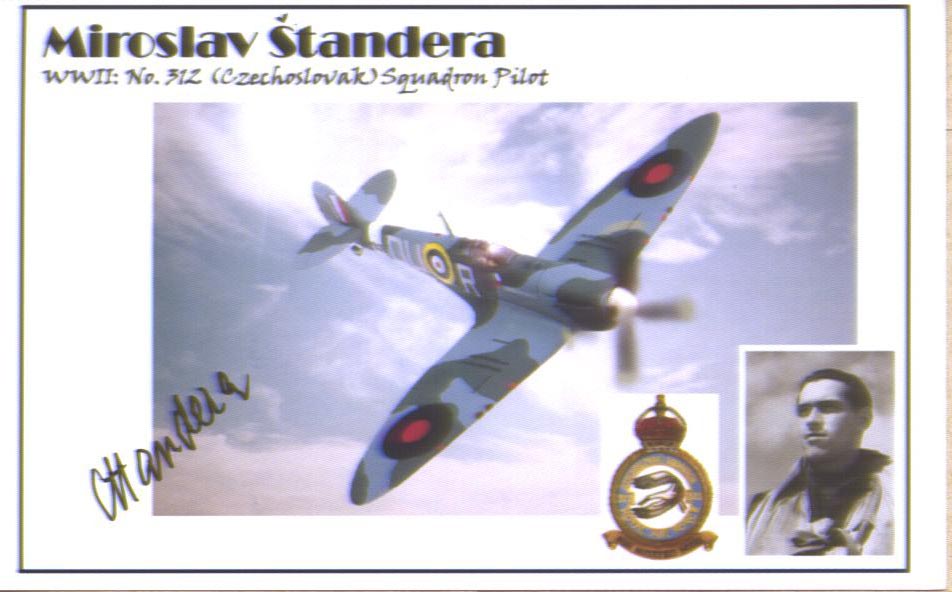
|
STANDERA Miroslav
Miroslav Štandera
Miroslav Štandera (October 5, 1918 – February 19, 2014) was a Czech fighter pilot who flew combat missions for the French Air Force and the Royal Air Force during World War II. Štandera was one of the final two surviving Czech combat pilots who flew for the Allies throughout the entire period of World War II.He was also the last surviving Czech pilot who had flown for France during the war.
Štandera was born on October 5, 1918. In 1936, he enlisted in the Czechoslovak Air Force and became an air force pilot after completing aviation school.
Miroslav Standera was one of the last surviving Czechoslovak fighter pilots who fought for both the French air force during the Battle of France and for the RAF during the rest of the Second World War. Having fled the Nazi takeover of Czechoslovakia in 1939 he found his way to France, already with 140 flying hours to his credit for the Czechoslovak Air Force during times of peace.
Once in France, by then itself threatened by the Nazi occupation, Standera was snapped up by the French and was retrained in flying French Morane Saulnier MS-406C fighters, first at BA-117 (Base Aérienne) in Paris and later at Chartres – flying patrols aimed, unsuccessfully, at holding back the Luftwaffe and the German invasion. At that time he was a Flight-Sergeant in the French Air Force.
On 11 June 1940, flying out of his base at Lognes-Emerainville, he was shot down near Epernay by a Messerschmitt Bf-109 from the Luftwaffe’s Jagdgeschwader-53 fighter wing nicknamed “Pik As” [Ace of Spades]. He was injured by gunfire but bailed out and was taken to hospital near Troyes. As the hospital was about to be overrun by the Nazis he was moved by train, eventually to the port of Sète to board an Egyptian freighter to Liverpool.
https://www.independent.co.uk/subscribe?utm_medium=prompt&utm_source=internal&utm_campaign=brexit_inline®SourceMethod=Standard+Article
After a spell in a camp for exiled Czechoslovak military personnel at Cholmondeley Park, Cheshire, he joined the RAF’s all-Czechoslovak 312 Squadron, based at RAF Duxford and flying Hurricane fighters in defence of British cities and of vital shipping. Because of his injuries he was not believed to have been among the 88 Czechoslovak fliers who took part in the Battle of Britain as it is usually defined.
He would later join RAF 68 (night-fighter) Squadron based variously at High Ercall, Shropshire, RAF Cranfield and Fairwood Common, South Wales, flying Bristol Beaufighters and Mosquitos, including providing air support for the D-Day landing forces and intercepting German V-1 “doodlebug” flying bombs. In all he flew 1,320 hours in combat and survived two crash landings in April 1944 with his navigator Karel Bednarik.
Miroslav Standera was born in Prague in 1918, days before the city witnessed Czechoslovakia’s declaration of independence from the collapsed Austro-Hungarian empire. His birth came six weeks before the Great War armistice but war would loom large in his life. He trained as a typographer but joined the Czechoslovakian Air Force in 1936 at the Military Aviation School in Prostejov before joining the 4th Aviation Regiment in Pardubice.
After the Nazis occupied Czechoslovakia in March 1939 he fled through Poland and then travelled by ship to France. Initially he and the many fellow Czechs who wished to fight had to sign up for the Foreign Legion, but once war was declared, he joined the Armée de l’Air.
Once the war was over he returned to his homeland a hero, but the freedom for which he had risked his life was short-lived. Soviet-backed communists took power in 1948 and life was made difficult, even hell, for those who had fought alongside Britons and Americans. As many of his old comrades were persecuted or even jailed, Standera fled for the second time in less than a decade.
Freedom for him and his compatriots was not easily won. He returned to the UK and was welcomed back into the RAF. On retirement he settled in London and built up a successful business as a silversmith and jeweller for around 35 years.
Pining for his real home, sensing the decline of communism and inspired by compatriots such as Vaclav Havel, he moved in 1983 to Bavaria in order, as he put it, “to be within sight of my native country.” Six years later, after the Velvet Revolution, he returned to his homeland, where the lived until his death in the west Bohemian city of Plzen (Pilsen), home of the renowned Pilsner Urquell beer.
As with all of the former war heros, Havel promoted Standera symbolically, from Flight Officer to Brigadier-General. He was named an honorary citizen- of Plzen and was awarded the French Legion of Honour.
Postwar composite photo measuring 4" x 6 1/2"
Price: $15.00
Please contact us before ordering to confirm availability and shipping costs.
Buy now with your credit card
other ways to buy
|


